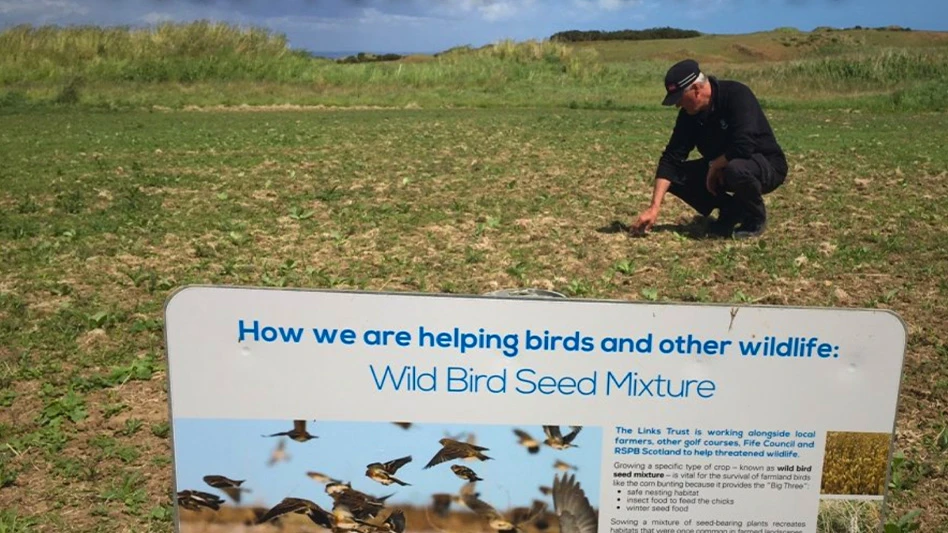
Areas of your course with poor drainage, little or no snow cover, heavy thatch buildup, or are subject to heavy winter traffic are all prone to winterkill, a common problem for turf professionals in much of North America. While the causes vary, the solutions to mitigate this springtime turf problem are easy to attain.
TEMPERATURE
From fall to spring, particularly when there is no snow cover, cold temperatures threaten golf course turf in the northern latitudes. In some locales, particularly in Canada, superintendents cover their greens during the winter. University of Tennessee turf researcher Dr. John Sorochan is familiar with the practice. He grew up in Western Canada, where winter temperatures have reached 35 below zero.
“Using the snow covers can help insulate the surface and provide protective layers,” he says. “If you had a snow cover, it adds a buffer from the really cold air temperatures.”
The trick is covering greens at the right time to avoid turf damage, Sorochan says. For example, the covers must be removed if late fall or winter temperatures become unseasonably warm. Failing to do so would allow the air temperatures underneath the cover to rise to unacceptable levels. And if the greens are covered prematurely, the turf beneath may not shut itself down for the winter.
“In Calgary, we actually had to shovel snow off our greens to put the covers on them,” Sorochan recalls. “You’d rather do that then put them on too soon and have the ground not freeze. You want it to freeze and get ready to harden off in the winter, but then you put the covers on them to keep them from getting exposed to too-low temperatures.”
ICE
Ice is a major superintendent concern during the winter months. Prolonged ice cover is potentially catastrophic. However, some turfgrass species are more vulnerable than others.
For example, Kentucky bluegrass and creeping bentgrass survived for up to 150 days under ice cover without significant damage, according to a 1998 study conducted by Dr. James B Beard. Annual bluegrass, however, survived only 75 to 90 days, likely the result of toxic gas issues.
If ice persists to the point where the turf is at risk, the superintendent must do what is necessary.
“You want to do whatever you can do because one (issue) is gas exchange,” Sorochan says. “You get lack of oxygen, and an accumulation of CO2. Cyanide has been known to kill bentgrass in Western Canada.
“I’ve seen some people do black-sand topdressing to kind of melt that ice a little bit, heat it up, do something if they can, to break up that ice layer,” he adds.
CROWN HYDRATION
During the winter, temperature fluctuations will result in stretches of melting followed by re-freezing. Bermudagrass greens in northern climates are particularly susceptible to these dramatic shifts.
“Basically, the plant starts to grow again and the crown imbibes water,” says Dr. Jim Kerns, assistant professor and extension specialist of turfgrass pathology at North Carolina State University. “Then, when cold temperatures occur, the water freezes inside the crown. As you can imagine this is fatal.”
As is the case with an abundance of turf issues, preventative maintenance is key. The turf should contain the proper amount of moisture heading into the cold weather, Sorochan says. “You want to maintain low crown hydration,” he says. “So, when they’re going into winter, make sure (the turf) is not too wet, but not bone dry.”
Striking the right balance between too much and two little moisture in the soil can be challenging, Sorochan adds, especially during a wet, rainy fall. It’s important the turf — greens in particular — drains properly. “Good drainage and having proper drainage on your greens is a combination of surface and sub-surface drainage,” he says so when it does get a lot of rain in the fall it’s going to be slower to drain because of colder temperatures.”
One way of reducing the risk of crown hydration during the winter is to avoid the temptation to put down too much nitrogen late in the season, Sorochan says. “You want to avoid late-fall nitrogen application,” he adds. “You don’t want it to become succulent, or get that late-season surge of growth. The plant’s leaf blades can’t harden off, the cells can’t harden off to partition the energy to the crowns and the stolons and rhizomes to store for the winter.”
DESICCATION
When cold winter temperatures and low-to-no snow combine with strong winds, turf can dry out and enter a state of extreme dryness known as desiccation. Concerns about desiccation explain why many superintendents are content to see snow covering their facility all winter long.
“It is very common in the Upper Plains states and Nebraska.” Kerns says. “We also see this in Bermudagrass as well. Wetting agents and covers are very helpful to protect against this.”
Areas most vulnerable to desiccation are open to the elements such as hills or areas that experience extreme temperature swings. The same topographic features that makes an area difficult to maintain in the summer, such as extensive tree cover, may help protect the area from desiccation. In addition, fencing installed around exposed areas will, in many circumstances, minimize the effects of the winds.
Even if the greens are covered for the winter, superintendents must be on their guard against snow mold. The most common U.S. varieties are pink (Microdochium patch or Microdochium nivale) and gray (Typhula blight or Typhula incarnate or T. ishikariensis). The former is most prevalent in cool, humid climates; snow cover is not required. In fact, it can occur year-round, most often when the temperature is somewhere around the freezing point to 60 degrees. The latter thrives under a snow cover.
It’s important for the superintendent to identify the species of snow mold he is dealing with. In many cases, this can be done by using a magnifying glass. Seeking assistance from, or providing samples to a turfgrass pathologist, will prove helpful, as well, according to the Purdue University Extension Service.
The best defense is a series of preventative fall fungicide applications, preferably after the season’s final mowing, Kern says. “In climates with extended snow covers, two applications are sufficient,” he says. “In the Pacific Northwest, multiple applications for pink snow mold may be needed.”
It is important to note that the superintendent should utilize a product or blend of products appropriate to his environment and follow label directions.

MICROCLIMATES
It’s essential a superintendent is aware of what’s going on throughout the property. The conditions on and around the seventh green may be quite different from those at the 11th tee. Be mindful of areas that may not get a lot of sun, which results in wet or damp conditions.
Microclimate is often left out of the conversation about winterkill, Kerns says. “Typically, winterkill only happens in certain areas on the course,” he says. “I always advocate ensuring the plant gets adequate air, light, food and water … [which] help with winterkill prevention.”
Microclimates have a big impact, says Dr. Kevin Frank, a Michigan State University turfgrass specialist who has observed differences in winterkill incidence between shaded and sunny greens. “Shaded sites usually have weaker turf and in many cases more Poa, thereby making them more susceptible to winterkill,” he says. “Snow and/or ice usually persists longer on shaded sites also.”

Explore the March 2017 Issue
Check out more from this issue and find your next story to read.
Latest from Golf Course Industry
- Making the grade — at or near grade
- PBI-Gordon receives local business honor
- Florida's Windsor takes environmental step
- GCSAA names Grassroots Ambassador Leadership Award winners
- Turf & Soil Diagnostics promotes Duane Otto to president
- Reel Turf Techs: Ben Herberger
- Brian Costello elected ASGCA president
- The Aquatrols Company story





